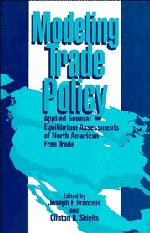Book contents
10 - A Dynamic Dual Model of the North American Free Trade Agreement
Published online by Cambridge University Press: 25 March 2010
Summary
Introduction
This paper develops a multiperiod, general equilibrium model of the Mexican economy to estimate the effects of NAFTA. The model assumes a small open economy that takes as given the world interest rate and prices of each traded industry (all except construction). The domestic interest rate is equal to the world rate plus a “risk-premium.” For each traded good, the domestic price is equal to the world price plus a tariff percentage. In line with the classification in the “Sistema de Cuentas Nacionales de México,” the model considers three capital goods industries (machines, buildings and vehicles) and nine consumption/intermediate goods activities (see Table 10.1).
The model has several features that make it particularly suitable for an analysis of the impact of NAFTA on the Mexican economy. Its construction involves the econometric estimation of 24 separate models (one unit cost function for the output and one unit cost function for physical capital in each industry).
An important feature of our model is that the dynamics of the response of the Mexican economy to changes in relative prices are based on intertemporal optimization by firms. This is especially important for simulations of trade liberalization, because expected future alterations in trade policies will have consequences for decisions in the present.
- Type
- Chapter
- Information
- Modeling Trade PolicyApplied General Equilibrium Assessments of North American Free Trade, pp. 301 - 327Publisher: Cambridge University PressPrint publication year: 1994
- 1
- Cited by



